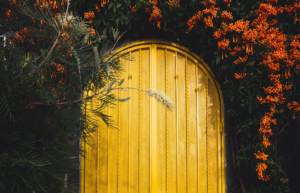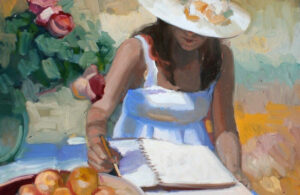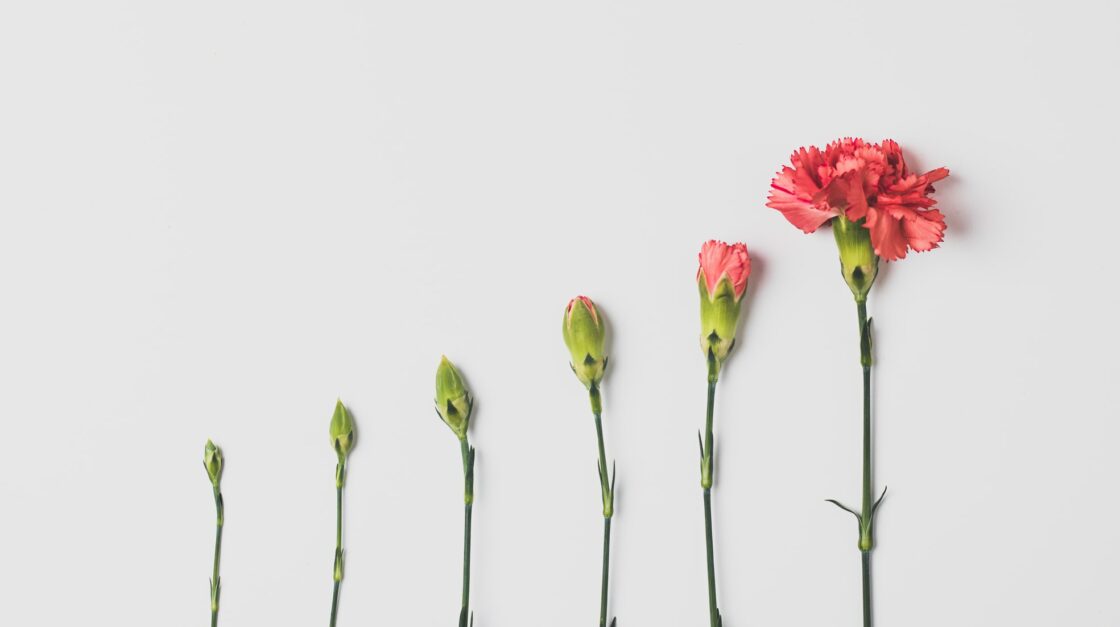Learning how to write a poem requires two things: a love of language, and a need for language to communicate more than it currently does. If this describes you, you’re in the right place to learn poetry.
This article is an in-depth introduction on how to write a poem. We first answer the question, “What is poetry?” We then discuss the literary elements of poetry, and showcase some different approaches to the writing process—including our own seven-step process on how to write a poem step by step.
So, how do you write a poem? Let’s start with what poetry is.
How to Write a Poem: Contents
What Poetry Is
It’s important to know what poetry is—and isn’t—before we discuss how to write a poem. The following quote defines poetry nicely:
“Poetry is language at its most distilled and most powerful.”
—Former US Poet Laureate Rita Dove
Poetry Conveys Feeling
People sometimes imagine poetry as stuffy, abstract, and difficult to understand. Some poetry may be this way, but in reality, poetry isn’t about being obscure or confusing. Poetry is a lyrical, emotive method of self-expression, and poets simply use the elements of poetry to highlight feelings and ideas.
A poem should make the reader feel something.
In other words, a poem should make the reader feel something—not by telling them what to feel, but by evoking feeling directly.
Here’s a contemporary poem that, despite its simplicity (or perhaps because of its simplicity), conveys heartfelt emotion.
Poem
by Langston Hughes
I loved my friend.
He went away from me.
There’s nothing more to say.
The poem ends,
Soft as it began—
I loved my friend.
Poetry is Language at its Richest and Most Condensed
Unlike longer prose writing (such as a short story, memoir, or novel), poetry needs to impact the reader in the richest and most condensed way possible. Here’s a famous quote that enforces that distinction:
“Prose: words in their best order; poetry: the best words in the best order.”
—Samuel Taylor Coleridge
So poetry isn’t the place to be filling in long backstories or doing leisurely scene-setting. In poetry, every single word carries maximum impact.
Article continues below…
Poetry Writing Courses We Think You'll Love
We've hand-picked these courses to help you flourish as a writer.

Toward Your Poetic Vision: A Guide Through the Poetic Life, from Craft to Publication
Write your most powerful poetry in this in-depth guidebook to the poet's craft and life.
Find Out More
Opening the Door to Poetry
How do we use poetry to express life's marvelous complexity? Learn how to control language beyond the "ordinary" and discover...
Find Out More
The Joy of Poetry: A Beginner-Friendly Workshop
Have you wanted to get into poetry, but don't know where to start? Learn the craft from the Joy of...
Find Out MoreOr click below to view all courses.
See CoursesArticle continues…
Poetry Uses Unique Elements
Poetry is not like other kinds of writing: it has its own unique forms, tools, and principles. Together, these elements of poetry help it to powerfully impact the reader in only a few words.
The elements of poetry help it to powerfully impact the reader in only a few words.
Most poetry is written in verse, rather than prose. This means that it uses line breaks, alongside rhythm or meter, to convey something to the reader. Rather than letting the text break at the end of the page (as prose does), verse emphasizes language through line breaks.
Poetry further accentuates its use of language through rhyme and meter. Poetry has a heightened emphasis on the musicality of language itself: its sounds and rhythms, and the feelings they carry.
These devices—rhyme, meter, and line breaks—are just a few of the essential elements of poetry. Let’s take a deeper look at them, as they’re essential to learning how to write a poem.
More About What Poetry Is
Learn more about what poetry is (and define it for yourself!) here:
https://writers.com/what-is-poetry
Understanding the Elements of Poetry
As we explore how to write a poem, these three major literary elements of poetry should sit in the back of your mind:
- Rhythm (Sound, Rhyme, and Meter)
- Form
- Literary Devices
1. Elements of Poetry: Rhythm
“Rhythm” refers to the lyrical, sonic qualities of the poem. How does the poem move and breathe; how does it feel on the tongue?
Traditionally, poets relied on rhyme and meter to accomplish a rhythmically sound poem. Free verse poems—which are poems that don’t require a specific length, rhyme scheme, or meter—only became popular in the West in the 20th century, so while rhyme and meter aren’t requirements of modern poetry, they are required of certain poetry forms.
Sound
Poetry is capable of evoking certain emotions based solely on the sounds it uses. Words can sound sinister, percussive, fluid, cheerful, dour, or any other noise/emotion in the complex tapestry of human feeling.
Take, for example, this excerpt from the poem “Beat! Beat! Drums!” by Walt Whitman:
Red — “b” sounds
Blue — “th” sounds
Green — “w” and “ew” sounds
Purple — “s” sounds
Orange — “d” and “t” sounds
This poem has a lot of percussive, disruptive sounds that reinforce the beating of the drums. The “b,” “d,” “w,” and “t” sounds resemble these drum beats, while the “th” and “s” sounds are sneakier, penetrating a deeper part of the ear. The cacophony of this excerpt might not sound “lyrical,” but it does manage to command your attention, much like drums beating through a city might sound.
To learn more about consonance and assonance, euphony and cacophony, onomatopoeia, and the other uses of sound, take a look at our article “12 Literary Devices in Poetry.”
https://writers.com/literary-devices-in-poetry
Rhyme
It would be a crime if you weren’t primed on the ins and outs of rhymes. “Rhyme” refers to words that have similar pronunciations, like this set of words: sound, hound, browned, pound, found, around.
Many poets assume that their poetry has to rhyme, and it’s true that some poems require a complex rhyme scheme. However, rhyme isn’t nearly as important to poetry as it used to be. Most traditional poetry forms—sonnets, villanelles, rimes royal, etc.—rely on rhyme, but contemporary poetry has largely strayed from the strict rhyme schemes of yesterday.
There are three types of rhymes:
- Homophony: Homophones are words that are spelled differently but sound the same, like “tail” and “tale.” (Homophones often lead to commonly misspelled words.)
- Perfect Rhyme: Perfect rhymes are word pairs that are identical in sound except for one minor difference. Examples include “slant and pant,” “great and fate,” and “shower and power.”
- Slant Rhyme: Slant rhymes are word pairs that use the same sounds, but their final vowels have different pronunciations. For example, “abut” and “about” are nearly-identical in sound, but are pronounced differently enough that they don’t completely rhyme. This is also known as an oblique rhyme or imperfect rhyme.
Meter
Meter refers to the stress patterns of words. Certain poetry forms require that the words in the poem follow a certain stress pattern, meaning some syllables are stressed and others are unstressed.
What is “stressed” and “unstressed”? A stressed syllable is the sound that you emphasize in a word. The bolded syllables in the following words are stressed, and the unbolded syllables are unstressed:
- Un•stressed
- Plat•i•tud•i•nous
- De•act•i•vate
- Con•sti•tu•tion•al
The pattern of stressed and unstressed syllables is important to traditional poetry forms. This chart, copied from our article on form in poetry, summarizes the different stress patterns of poetry.
| Meter | Pattern | Example |
| Iamb | Unstressed–stressed | Exist |
| Trochee | Stressed–unstressed | Sample |
| Pyrrh | Equally unstressed | Pyrrhic |
| Spondee | Equally stressed | Cupcake |
| Dactyl | Stressed–unstressed–unstressed | Freshener |
| Anapest | Unstressed–unstressed–stressed | Comprehend |
| Amphibrach (rare) | Unstressed–stressed–unstressed | Flamingo |
Learn more about meter here:
2. Elements of Poetry: Form
“Form” refers to the structure of the poem. Is the poem a sonnet, a villanelle, a free verse piece, a slam poem, a contrapuntal, a ghazal, a blackout poem, or something new and experimental?
Form also refers to the line breaks and stanza breaks in a poem. Unlike prose, where the end of the page decides the line breaks, poets have control over when one line ends and a new one begins. The words that begin and end each line will emphasize the sounds, images, and ideas that are important to the poet.
All poems are a negotiation between form and language, between restraint and release. The more you explore the forms and possibilities of poetry, the more you can communicate complex ideas in different ways.
Form is no easy topic to summarize, but it’s essential to practice with as you learn how to write a poem. To learn more about rhyme, meter, and poetry forms, read our full article on the topic:
https://writers.com/what-is-form-in-poetry
3. Elements of Poetry: Literary Devices
“Poetry: the best words in the best order.” — Samuel Taylor Coleridge
How does poetry express complex ideas in concise, lyrical language? Literary devices—like metaphor, symbolism, juxtaposition, irony, and hyperbole—help make poetry possible. They express complex ideas concisely, and they help readers see the world in new, strange, and powerful ways.
Like form, the study of literary devices is essential to learning how to write a poem, but there are also far too many to include in this article. Learn how to write and master literary devices here:
https://writers.com/common-literary-devices
How to Write a Poem, in 7 Steps
To condense the elements of poetry into an actual poem, we’re going to follow a seven-step approach. However, it’s important to know that every poet’s process is different. While the steps presented here are a logical path to get from idea to finished poem, they’re not the only tried-and-true method of poetry writing. Poets can—and should!—modify these steps and generate their own writing process.
Nonetheless, if you’re new to writing poetry or want to explore a different writing process, try your hand at our approach. Here’s how to write a poem step by step!
1. Devise a Topic
The easiest way to start writing a poem is to begin with a topic.
However, devising a topic is often the hardest part. What should your poem be about? And where can you find ideas?
Here are a few places to search for inspiration:
- Other Works of Literature: Poetry doesn’t exist in a vacuum—it’s part of a larger literary tapestry, and can absolutely be influenced by other works. For example, read “The Golden Shovel” by Terrance Hayes, a poem that was inspired by Gwendolyn Brooks’ “We Real Cool.”
- Real-World Events: Poetry, especially contemporary poetry, has the power to convey new and transformative ideas about the world. Take the poem “A Cigarette” by Ilya Kaminsky, which finds community in a warzone like the eye of a hurricane.
- Your Life: What would poetry be if not a form of memoir? Many contemporary poets have documented their lives in verse. Take Sylvia Plath’s poem “Full Fathom Five”—a daring poem for its time, as few writers so boldly criticized their family as Plath did.
- The Everyday and Mundane: Poetry isn’t just about big, earth-shattering events: much can be said about mundane events, too. Take “Ode to Shea Butter” by Angel Nafis, a poem that celebrates the beautiful “everydayness” of moisturizing.
- Nature: The Earth has always been a source of inspiration for poets, both today and in antiquity. Take “Wild Geese” by Mary Oliver, which finds meaning in nature’s quiet rituals.
- Writing Exercises: Prompts and exercises can help spark your creativity, even if the poem you write has nothing to do with the prompt! Here’s 24 writing exercises to get you started, and some poetry prompts that might help you, too.
2. Journal
At this point, you’ve got a topic for your poem. Maybe it’s a topic you’re passionate about, and the words pour from your pen and align themselves into a perfect sonnet! It’s not impossible—most poets have a couple of poems that seemed to write themselves.
However, it’s far more likely you’re searching for the words to talk about this topic. This is where journaling comes in.
Sit in front of a blank piece of paper, with nothing but the topic written on the top. Set a timer for 15-30 minutes and put down all of your thoughts related to the topic. Don’t stop and think for too long, and try not to obsess over finding the right words: what matters here is emotion, the way your subconscious grapples with the topic.
At the end of this journaling session, go back through everything you wrote, and highlight whatever seems important to you: well-written phrases, poignant moments of emotion, even specific words that you want to use in your poem.
Journaling is a low-risk way of exploring your topic without feeling pressured to make it sound poetic. “Sounding poetic” will only leave you with empty language: your journal allows you to speak from the heart. Everything you need for your poem is already inside of you, the journaling process just helps bring it out!
Learn more about keeping a daily journal here:
How to Start Journaling: Practical Advice on How to Journal Daily
3. Think About Form
As one of the elements of poetry, form plays a crucial role in how the poem is both written and read. Have you ever wanted to write a sestina? How about a contrapuntal, or a double cinquain, or a series of tanka? Your poem can take a multitude of forms, including the beautifully unstructured free verse form; while form can be decided in the process of revising and editing, it doesn’t hurt to think about it now.
4. Write the First Line
After a productive journaling session, you’ll be much more acquainted with the state of your heart. You might have a line in your journal that you really want to begin with, or you might want to start fresh and refer back to your journal when you need to! Either way, it’s time to begin.
What should the first line of your poem be? There are no strict rules of poetry here—you don’t have to start your poem with a certain image or literary device. However, here’s a few ways that poets often begin their work:
- Set the Scene: Poetry can tell stories just like prose does. Anne Carson does just this in her poem “Lines,” situating the scene in a conversation with the speaker’s mother.
- Start at the Conflict: Right away, tell the reader where it hurts most. Margaret Atwood does this in “Ghost Cat,” a poem about aging.
- Start With a Contradiction: Juxtaposition and contrast are two powerful tools in the poet’s toolkit. Joan Larkin’s poem “Want” begins and ends with these devices. Carlos Gimenez Smith also begins his poem “Entanglement” with a juxtaposition.
- Start With Your Title: Some poets will use the title as their first line, like Ron Padgett’s poem “Ladies and Gentlemen in Outer Space.”
There are many other ways to begin poems, so play around with different literary devices, and when you’re stuck, turn to other poetry for inspiration. You can learn more about starting a poem here:
5. Develop Ideas and Devices
You might not know where your poem is going until you finish writing it. In the meantime, stick to your literary devices. Avoid using too many abstract nouns. Additionally, develop striking images, use metaphors and similes to strike interesting comparisons, and above all, speak from the heart.
6. Write the Closing Line
Some poems end “full circle,” meaning that the images the poet used in the beginning are reintroduced at the end. Gwendolyn Brooks does this in her poem “my dreams, my work, must wait till after hell.”
Yet, many poets don’t realize what their poems are about until they write the ending line. Poetry is a search for truth, especially the hard truths that aren’t easily explained in casual speech. Your poem, too, might not be finished until it comes across a necessary truth, so write until you strike the heart of what you feel, and the poem will come to its own conclusion.
7. Edit, Edit, Edit!
Do you have a working first draft of your poem? Congratulations! Getting your feelings onto the page is a feat in itself.
Yet, no guide on how to write a poem is complete without a note on editing. If you plan on sharing or publishing your work, or if you simply want to edit your poem to near-perfection, keep these tips in mind.
- Adjectives and Adverbs: Use these parts of speech sparingly. Most imagery shouldn’t rely on adjectives and adverbs, because the image should be striking and vivid on its own, without too much help from excess language.
- Concrete Line Breaks: Line breaks help emphasize important words, making certain images and themes clearer to the reader. As a general rule, most of your lines should start and end with concrete words—nouns and verbs especially.
- Stanza Breaks: Stanzas are like paragraphs to poetry. A stanza can develop a new idea, contrast an existing idea, or signal a transition in the poem’s tone. Make sure each stanza clearly stands for something as a unit of the poem.
- Mixed Metaphors: A mixed metaphor is when two metaphors occupy the same idea, making the poem unnecessarily difficult to understand. Here’s an example of a mixed metaphor: “a watched clock never boils.” The meaning can be discerned, but the image remains unclear. Be wary of mixed metaphors—though some poets (like Shakespeare) make them work, they’re tricky and often disruptive.
- Abstractions: Above all, avoid using excessively abstract language. It’s fine to use the word “love” 2 or 3 times in a poem, but don’t use it twice in every stanza. Let the imagery in your poem express your feelings and ideas, and only use abstractions as brief connective tissue in otherwise-concrete writing.
Lastly, don’t feel pressured to “do something” with your poem. Not all poems need to be shared and edited. Poetry doesn’t have to be “good,” either—it can simply be a statement of emotions by the poet, for the poet. Publishing is an admirable goal, but also, give yourself permission to write bad poems, unedited poems, abstract poems, and poems with an audience of one. Write for yourself—editing is for the other readers.
How to Write a Poem: Different Approaches and Philosophies
Poetry is the oldest literary form, pre-dating prose, theater, and the written word itself. As such, there are many different schools of thought when it comes to writing poetry. You might be wondering how to write a poem through different methods and approaches. Here are four philosophies to get you started.
How to Write a Poem: Poetry as Emotion
If you asked a Romantic Poet “what is poetry?”, they would tell you that poetry is the spontaneous emotion of the soul.
The Romantic Era viewed poetry as an extension of human emotion—a way of perceiving the world through unbridled creativity, centered around the human soul. While many Romantic poets used traditional forms in their poetry, the Romantics weren’t afraid to break from tradition, either.
To write like a Romantic, feel—and feel intensely. The words will follow the emotions, as long as a blank page sits in front of you.
How to Write a Poem: Poetry as Stream of Consciousness
If you asked a Modernist poet, “What is poetry?” they would tell you that poetry is the search for complex truths.
Modernist Poets were keen on the use of poetry as a window into the mind. A common technique of the time was “Stream of Consciousness,” which is unfiltered writing that flows directly from the poet’s inner dialogue. By tapping into one’s subconscious, the poet might uncover deeper truths and emotions they were initially unaware of.
Depending on who you are as a writer, Stream of Consciousness can be tricky to master, but this guide covers the basics of how to write using this technique.
How to Write a Poem: Mindfulness
Mindfulness is a practice of documenting the mind, rather than trying to control or edit what it produces. This practice was popularized by the Beat Poets, who in turn were inspired by Eastern philosophies and Buddhist teachings. If you asked a Beat Poet “what is poetry?”, they would tell you that poetry is the human consciousness, unadulterated.
To learn more about the art of leaving your mind alone, take a look at our guide on Mindfulness, from instructor Marc Olmsted.
https://writers.com/mindful-writing
How to Write a Poem: The “After” Poem
Did another poem really inspire you? Do you want to write a poem like that one, or borrow a technique that poet used? Poets are borrowing from each other all the time—but the key word is “borrow,” as they don’t steal or plagiarize.
Other poetry is a great way to create doorways into your own work. You will also expand your poetic toolkit by experimenting with different styles and voices. If you want to write a poem that builds upon the work of another, write an “after” poem—a poem that is written “after” the poet that inspired you. Other poetry is a great way to search for inspiration. An example of an “after” poem is Ocean Vuong’s poem “Someday I’ll Love Ocean Vuong”, which is “after” Roger Reeves and Frank O’Hara. (O’Hara has a poem in which he says “someday I’ll love Frank O’Hara.”
Be sure you also know how to read poetry like a poet.
How to Write a Poem: Poem as Camera Lens
Many contemporary poets use poetry as a camera lens, documenting global events and commenting on both politics and injustice. If you find yourself itching to write poetry about the modern day, press your thumb against the pulse of the world and write what you feel.
Additionally, check out these two essays by Electric Literature on the politics of poetry:
- What Can Poetry Do That Politics Can’t?
- Why All Poems Are Political (TL;DR: Poetry is an urgent expression of freedom).
Okay, I Know How to Write a Poem. What Next?
Poetry, like all art forms, takes practice and dedication. You might write a poem you enjoy now, and think it’s awfully written 3 years from now; you might also write some of your best work after reading this guide. Poetry is fickle, but the pen lasts forever, so write poems as long as you can!
Once you understand how to write a poem, and after you’ve drafted some pieces that you’re proud of and ready to share, here are some next steps you can take.
Publish in Literary Journals
Want to see your name in print? These literary journals house some of the best poetry being published today.
https://writers.com/best-places-submit-poetry-online
Assemble and Publish a Manuscript
A poem can tell a story. So can a collection of poems. If you’re interested in publishing a poetry book, learn how to compose and format one here:
https://writers.com/poetry-manuscript-format
How to Write a Poem: Join a Writing Community
Writers.com is an online community of writers, and we’d love it if you shared your poetry with us! Join us on Facebook and check out our upcoming poetry courses.
Poetry doesn’t exist in a vacuum, it exists to educate and uplift society. The world is waiting for your voice, so find a group and share your work!



super useful! love these articles 💕
Finally found a helpful guide on Poetry’.
For many year, I have written and filed numerous inspired pieces from experiences and moment’s of epiphany.
Finally, looking forward to convertinb to ‘poetry format’.
THANK YOU, KINDLY.
🙏🏾
Indeed, very helpful, consize. I could not say more than thank you.
Wow! This is so sureal! This is the most amazing poetry writing guide I have ever read. Thank you for sharing this simple and practical tips😍😍😍
I’ve never read a better guide on how to write poetry step by step. Not only does it give great tips, but it also provides helpful links!
Thank you so much.
Thank you very much, Hamna! I’m so glad this guide was helpful for you.
Best guide so far
hey can you help me with my poems
Very inspirational and marvelous tips
Thank you super tips very helpful.
I have never gone through the steps of writing poetry like this, I will take a closer look at your post.
Beautiful! Thank you! I’m really excited to try journaling as a starter step x
[…] How to Write a Poem, Step-by-Step […]
This is really helpful, thanks so much
Extremely thorough! Nice job.
Thank you so much for sharing your awesome tips for beginner writers!
People must reboot this and bookmark it. Your writing and explanation is detailed to the core. Thanks for helping me understand different poetic elements. While reading, actually, I start thinking about how my husband construct his songs and why other artists lack that organization (or desire to be better). Anyway, this gave me clarity.
I’m starting to use poetry as an outlet for my blogs, but I also have to keep in mind I’m transitioning from a blogger to a poetic sweet kitty potato (ha). It’s a unique transition, but I’m so used to writing a lot, it’s strange to see an open blog post with a lot of lines and few paragraphs.
Anyway, thanks again!
I’m happy this article was so helpful, Eternity! Thanks for commenting, and best of luck with your poetry blog.
Yours in verse,
Sean
One of the best articles I read on how to write poems. And it is totally step by step process which is easy to read and understand.
Thanks for the step step explanation in how to write poems it’s a very helpful to me and also for everyone one.
THANKYOU
Totally detailed and in a simple language told the best way how to write poems. It is a guide that one should read and follow. It gives the detailed guidance about how to write poems. One of the best articles written on how to write poems.
what a guidance thank you so much now i can write a poem thank you again again and again
The most inspirational and informative article I have ever read in the 21st century.It gives the most relevent,practical, comprehensive and effective insights and guides to aspiring writers.
Thank you so much. This is so useful to me a poetry
[…] Write a short story/poem (Here are some tips) […]
It was very helpful and am willing to try it out for my writing
Thanks ❤️
Thank you so much. This is so helpful to me, and am willing to try it out for my writing .
Absolutely constructive, direct, and so useful as I’m striving to develop a recent piece. Thank you!
thank you for your explanation……,love it
Really great. Nothing less.
I can’t thank you enough for this, it touched my heart, this was such an encouraging article and I thank you deeply from my heart, I needed to read this.
thanks!!!
great teaching Did not know all that in poetry writing
This was very useful! Thank you for writing this.
After reading a Charles Bukowski poem, “My Cats,” I found you piece here after doing a search on poetry writing format. Your article is wonderful as is your side article on journaling. I want to dig into both and give it another go another after writing poetry when I was at university. Thank you!
Thanks for reading, Vicki! Let us know how we can support your writing journey. 🙂
Sean
Thank you for the nice and informative post. This article truly offers a lot more details about this topic.
Very useful information. I’m glad to see you discussed rhyming, too. I was in the perhaps mistaken idea that rhyming is frowned upon in contemporary poems.
Thanks alot this highly needed for a starter like me
Thanks for this Beautiful 🌹 step by step piece. As I dive into learning how to write poems I will probably find them helpful and refer to them later on again when needed.
Thanks♥️
I saw my pitfalls, thanks for this beautiful piece.
Can anyone recommend a good online poetry class?
Thank you for the step-by-step explanation. It will help me in polishing my poetry.
Such a useful and encouraging article; very well laid out too. Many thanks for sharing your wisdom, experience and insights Sean. With gratitude, Lou
Wow! This is so sureal! This is the most amazing poetry writing guide I have ever read. Thank you for sharing this simple and practical tips😍😍😍
Thank you for these helpful and easy-to-follow tips—perfect for a beginner like me!
[…] How to Write a Poem: Examples and Analysis | Writers.com […]